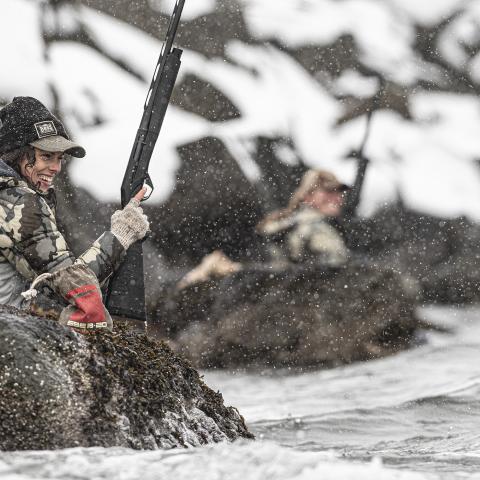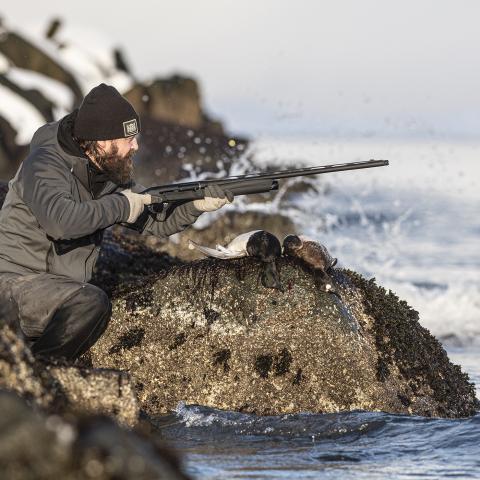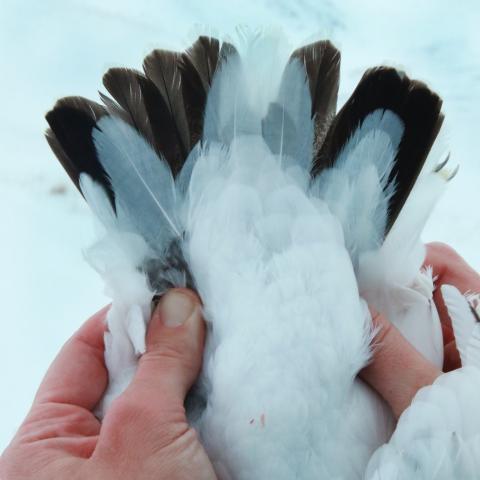Into the Unknown
The cold air froze my lungs with every deep gasp for oxygen. My gloves were soaked through, making my fingers too numb to feel the cold as one hand was buried deep in the snow to keep my body upright. I was on my knees, dry heaving on the side of a mountain. I had just summitted, racing upwards through knee-deep snow to close the distance on a brace of ptarmigan sitting on the peak.
Between the sound of my heavy breathing, I heard footsteps breaking the crust of the snow and looked up to see my friend, Natalie, pushing her way through the deep drifts to my location.
“Dude, are you puking?” she yelled over the howling wind. Her voice admitted half concern, half amusement.
I raised my non-buried hand into the air. In it lay a ptarmigan, its white and black plumage standing contrast against the snow. Then I heaved some more.
Adak Island
The wheels of our plane touched down on a snow-covered tarmac on an island in the middle of the Pacific, just a stone’s throw away from Russia. Our small hunting group—nicknamed “The Wolfpack” after 10 days together on a remote island in Alaska—consisted of my friend, Natalie Krebs, and Team BOSS Shotshells which included co-founder Lee Kjos, and his son Luke Kjos, and Zach Myers.
Our journey was to the edge of the Earth—to Adak, one of the many islands that make up the famous Aleutian Islands. Stretching southwest from the tip of the Alaskan Peninsula, this chain of islands would become an influential part of American history for the role they played in World War II, and later in the Cold War. In 1942, during the Battle of Midway, Japanese forces invaded and came to occupy the far western Aleutian Islands of Attu and Kiska—the first occupation of U.S. soil since 1812. This caused the U.S. to kick it in to high gear to place a defense in the way of the Japanese. In just 10 days, 4,500 U.S. military personnel landed on Adak and a runway was built to launch airstrikes on Attu and Kiska.
When the threat from communist regimes faded, so did Adak and its importance to the U.S. and its military presence in the Aleutians. In 1995, the naval base was decommissioned, and the personnel removed, leaving behind the remains of the military installation that once played such a key role in American history.
Apocalypse Now
Our Wolfpack was traveling across the Pacific to hunt this historic island for its plethora of wild game. A multitude of sea ducks migrate through the chain of islands to winter, Chamberlain’s ptarmigan watch the island from its rocky mountain peaks, and caribou were introduced to Adak in 1958.
We were greeted in the one-room Adak airport by Scott Bullock, co-owner of Aleutian Outfitters. Scott and his business partner, Cory Herendeen, call the remote island home for half of each year.
As we made our way across the island in an old, weathered Suburban, Scott explained the unusual weather the island was experiencing. Nicknamed the “Birthplace of the Winds” for its everyday squalls, Scott described how snow was unusual for Adak. In a normal year, the mountains would be lush and green with rain pummeling the island daily.
As a Nirvana cassette played through the tape player, I took in my surroundings. We were driving through what mimicked an apocalypse movie. Roads were unmaintained and unplowed, and large structures stood abandoned and dilapidated. Windows were broken, schoolyard playground equipment was rusted and rotting, and we could see inside housing units where the walls had crumbled to expose rooms with furniture, and warehouses filled with dusty equipment. It was as if the people stationed here had dropped everything and left the island with only the clothes on their backs.
Untouched Wild
The “Watch for Unexploded Ordinances” sign unnerves me a bit as we make our way to the harbor long before daybreak on our first morning. A Sea Osprey sport fishing boat named “Y Knot” sits tied in the freezing waters, waiting for us to board and begin our journey to sea.
Waves bang against the hull as we make our way out of the harbor, while Adak’s mountains stand tall and ominous to our starboard side. An expert sea captain, Cory studies the nautical weather reports each day to determine if the waters are safe to traverse to reach prime hunting spots.
Sea duck hunting is a unique experience: no blinds and no calling. Locate the comfiest rock along the seashore you can find, hold still, and be ready to swing on fast flying ducks who cross your decoys in the blink of an eye.
I was hunting with three die-hard waterfowlers, each whispering in school-girl excitement about what sea ducks could cup their wings to land in our spread. North America gets its fair share of waterfowl species crossing its borders, but because we are so far north, geese such as the iconic emperor fly through the Aleutians. Other species such as canvasback, harlequin, Eurasian wigeon, bufflehead, greater scaup, and common eider are also names whispered through the darkness as the clank of shotgun actions close on our Benelli’s.
Having hunted sea ducks once before, I should have been prepared to lead the fast-flying fowl when a bufflehead first skirted through our decoys, but my shot pattern behind the duck proved I was too slow. Over the course of the week, our group average would significantly raise as we got ahead of the ducks that fly mere inches above the water—and fast. Zac would bring down a beautiful canvasback, Luke a couple of greater scaup, me with my first drake Harley, and Natalie would shoot a true, and rare, trophy: a tufted duck.
Wild Adventure
When the ducks stopped flying midmorning, we turned to the ptarmigan to fill our afternoons.
A bird dog at heart, my waterfowl obsessed friends looked at me like I was lacking braincells as I ditched my waders for gaiters every day. My heart lies in upland hunting, and although I was missing my dogs, the hunt for ptarmigan on this remote isle was calling to me.
Natalie would join me in one of my climbs up the steep, snow-covered mountains. Our footprints were the first to disturb the snow that blanketed the landscape—potholing through drifts up to our knees. Multiple times one of our bodies would disappear into the earth, dropping into disguised snow drifts that buried us to our hips.
The weather had moved in quickly. Raging wind caused snow to blanket the blue skies that had been overhead when Natalie and I started our trek up the mountain overlooking the harbor for ptarmigan.
The scenery disappeared in the whiteout, but the squall sending ice to bite at my cheeks couldn’t dampen my spirits. I was on Cloud 9 on this remote isle. Our week had been spent in pursuit of wild adventure. Between our days making our mark on these mountains, and evenings spent taking a step back in history and exploring the apocalyptic military base; and singing along to Nirvana as we dug out vehicles stuck in bumper height snow—this had been a trip of a lifetime.
We met at the peak of the mountain, questioning our sanity for potholing this far up for a small upland bird. Cold and weary, we decided to descend and rejoin The Wolfpack. As we made our way around the mountain, the whiteout moved out as quickly as it moved in. And that’s when I saw it: a lone ptarmigan flush.
It had flown above our position. Having come this far, gaining elevation—again—be damned, I was going after that bird. By the time I closed the distance, I was wheezing with exertion, sure my heavy breathing could be heard down in the harbor and cause the bird to flush wild. But it held its position, thinking that landing on the steepest peak with the thickest snow drifts would keep it safe.
I was racing upwards, forcing my legs up and down through the heavy drifts. When I took the shot, my shotgun blast echoed off the mountain. Before the reverberation stopped, I was racing to gather my quarry before a watching eagle swooped in to steal my bird (as one had done earlier in the week…).
As I admired the Chamberlain in my hand, a movement at the peak caught my eye. A brace of ptarmigan had skylined themselves at the summit above me.
I looked back at my friend, and she knew where my mind was. When would we find ourselves on an island in the middle of the Pacific again hunting these birds? I put one foot in front of the other and started upwards. The ptarmigan looked like royalty, standing tall on the one exposed rock that wasn’t buried.
When Natalie reached me, I was gasping for air, spit falling from my mouth—but I had one of those ptarmigan in hand. Even I was able to laugh at my state as she sat next to me. We didn’t talk much, maybe because I couldn’t breathe, but instead stared down at the crumbling buildings of the past and knew that we had engrained part of ourselves in this unique place.
We held our trophies high for The Wolfpack to see as we made the final ascent to the Suburban where the guys waited patiently for our return. They raised their arms in triumph for us—Nirvana playing through the speakers.
Content Courtesy of GUN DOG

Photo by Lee Kjos

Photo by Lee Kjos

Photo by Lee Kjos


